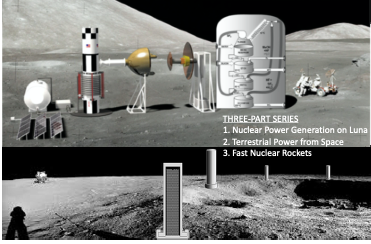Ultra-Safe Nuclear Power in Space 12 hours
This course presents and explores a new solution, whereby the nuclear fuel is created from minerals found naturally on the surface of the Moon, 384,000 km away.
$2000 USD

Ultra-Safe Nuclear Power in Space
Exploration of space, and commercial exploitation of space resources, requires ample power for life support, propulsion, and industrial activity. Solar power is diffuse and requires line-of-sight to the sun. To engineers, nuclear power is a beautiful answer. To those concerned with Earth’s environment, launching nuclear reactors is anathema. This course presents and explores a new solution, whereby the nuclear fuel is created from minerals found naturally on the surface of the Moon, 384,000 km away. In addition to keeping radioactive material far, far from our homeworld biosphere, the nuclear fuel is based on the “233” isotope of uranium. This is not used on Earth because it does not make bombs – which is exactly why we want to use it in space. Yes, it still makes radioactive waste, however, the U-233 fission byproducts decay to safe levels in about 80 years. This compares very favorably to the byproducts of U-235, used everywhere on Earth, that last for many millennia. These features make this new method of nuclear power in space to be “Ultra-safe”. In this lecture series, you will learn about this recent breakthrough and each step needed to bring it to reality. In a few more years, this course will be obsolete, because this technology will already be established. Now is the time to learn, and to become part of the leading edge in space power technology. Combined with energy storage and power beaming technologies also invented by the author, you can become one of the first to learn how power and energy will be generated, transmitted, and stored in space for the rest of history. Enroll now, and reserve your place.
12 hours
Reading/Viewing for the Course:
- General engineering knowledge
- Awareness of nuclear chemistry and physics
- Understanding of space environments
- Appreciation for orbital mechanics and rocketry
- Interest to explore new paradigms
Learning Objectives
Attendees will learn of a recent breakthrough in space nuclear power that does not require fissile material to be launched from Earth. This “Ultra-safe” approach shatters existing paradigms of power generation, and enables large-scale in situ resource utilization on the Moon, and at asteroids. This series of lectures build the capabilities step-by-step so that the participant has a clear understanding of the methods and the financial requirements to establish a thriving nuclear power industry on the surface of the Moon. Upon completion of this course, the participant will understand how to bootstrap the human ecosphere beyond GEO, and unlock the incredible resources of the Main Belt rocky bodies. All of this is oriented towards improving life on Earth for as many people as possible, all while earning astronomical profits. Yet, the same technology can also expand the options for people living and traveling safely in space, ushering in a new era of exploration and comfortable living in orbit or on planetary bodies. All of this is possible without broaching the Outer Space Treaty, and helps create a nuclear power infrastructure based on the transmutation of thorium, such that radioactive byproducts decay to safe levels within just 80 years of their life in a fission reactor. Imaginative and entrepreneurial students will see limitless possibilities for their own contributions to the burgeoning enterprise of space to be ushered in by this newly-discovered (2019) means to ultra-safe nuclear power in space.
TEXTBOOK
Space Systems Architecture for Resource Utilization, Peter J. Schubert, Cambridge Scholars Publishing (2021) ISBN-13: 978-1527567658
COURSE OUTLINE:
1. First-generation nuclear power on Luna
– density separation of Th-bearing minerals
– transmutation of Th to U-233
– first simple reactor for 2MWe
2. Nuclear powersats to provide baseload power to municipalities on Earth
– second-generation thorium refining
– precision fuel rods
– in-space activation of controlled chain reaction
– always-on power delivered wirelessly to terrestrial utilities
3. Fast nuclear rockets
– THOREX process adapted to lunar environment
– hydrogen generation and storage by in situ resource utilization
– radiation protection for long-range human crews
– within-one-year round-trip to asteroids
Instructor Biography
Peter J. Schubert is a licensed Professional Engineer in microelectronics in the State of Illinois, in the United States. He holds a doctorate from Purdue, and he is a full professor of engineering at the Purdue School of Engineering & Technology at IUPUI (Indiana University-Purdue University Indianapolis). He also serves as director of the renewable energy research center for the university. In that role, he explores power and resources from space, including his 2019 discovery of the means to produce U-233 from lunar thorium. Dr. Schubert is also the President and CEO of Green Fortress Engineering, or GFE. GFE is a cleantech company started in 2016 by the Indiana University system. It aims to commercialize biomass to hydrogen, hydrogen storage, and in situ resource utilization for space – all based on Dr. Schubert’s many patents. His total count is now 43 in the US and 13 in the EU, 8 of which are overlapping. Schubert recently published a textbook for space resource utilization with Cambridge Scholars Press. He was recognized by the US Department of State with a Fulbright Specialist position to Malta to work on waste-to-energy systems. Dr. Schubert has received grants from NASA, the National Science Foundation, the Department of Energy, the Department of Defense, and the US Department of Agriculture.
Dr. Peter Schubert
Instructor
Dr. Peter J. Schubert is a licensed Professional Engineer in microelectronics in the State of Illinois, in the United States. He holds a doctorate from Purdue, and he is a full professor of engineering at the Purdue School of Engineering & Technology at IUPUI (Indiana University-Purdue University Indianapolis).
FAQs
Who can enroll?
When do courses start?
Will the sessions be recorded?
How do I take a course?
What are the requirements to become a student?
The platform is available on desktops and mobile devices. Please have your mic and camera ready to participate. Develop new skills and gain new experiences as you learn alongside others building humanity’s future in space.



